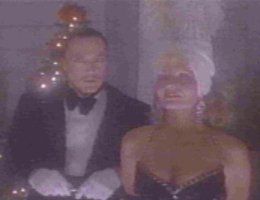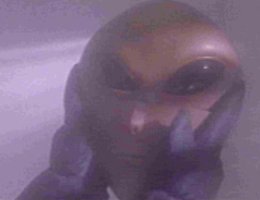Perhaps the most obvious example of mimicry that Cornet has witnessed and recorded on film is the Boeing 707 look-a-like that followed him home from work one day at dusk on 24 September 1992. Three months earlier he witnessed either the same craft or a similar one unfold wings and turn on sound. That sighting before a small group of skywatchers might have been dismissed by skeptics had they not jumped in their cars and chased the AOP for two miles before catching up to it. Conventional fixed-wing aircraft cannot fly at highway speeds for motor vehicles, and they cannot fly without conventional engines. The Boeing 707 look-a-like had no visible engine pods on its wings or fuselage. It was solid black, and had no visible windows - even up front where the flight deck would be situated.
Perhaps the most important feature of triangular or angular craft is their blacker-than-black surface, which makes them very low observable if they turn off their lights. Harv Howard talks about this feature in his article, Estimate of the Situation 2000: The Black Triangles. Such craft are rarely seen during the day, because they would stand out against a light blue sky - more so than conventional aluminum-sided aircraft, which tend to blend in with the sky. We need to be aware that advanced technology tends to be stealthy through efficiency (less waste heat, faster, etc., because interaction with the environment results in energy dissipation).
So, why then would these craft attempt to mimic the patterns of conventional aircraft navigation lights when all they would have to do is turn off their lights to become invisible at night? Why would these craft put on performances before selected individuals, such as before four police officers in Illinois recently (5 January 2000)? These sightings are the subject of a one hour documentary produced by Termite Arts Productions for the Discovery channel (UFO over Illinois, premiers on 30 November at 9:00 pm EST; 1 December at 1:00 am EST; 2 December at 5:00 pm EST).
In some cases these craft came back time after time when Cornet went out into the field to study them. He got the impression that they were giving him information and/or attempting to communicate in ways that would be familiar to Cornet. He also got the impression that they wanted feed-back and were using him for quality control, as it were. In other words, the intelligence behind these performances was trying to mimic conventional aircraft, and wanted to find out if Cornet could be fooled. And yet during each performance the craft would present information that made them distinct from conventional aircraft. Perhaps this information was intentional, or perhaps the intelligence wanted to know what it was about those features that made Cornet suspicious. And then again, perhaps that intelligence was testing his abilities to identify their craft as distinct from conventional aircraft.
After all, if NASA were successful in sending either manned probes or probes with artificial intelligence to distant star systems and discovered a planet with intelligent life on it, wouldn't it make sense for the engineers of the probe to give it the capability of mimicry, so that it could observe the life on that planet without attracting attention?
And if the probe attempted to make contact with intelligent beings on that planet, wouldn't it make sense to communicate in ways that would be non-threatening? Communication might require various experiments in order to find common ground and an understanding of how the intelligent life on that planet thinks and communicates. What is "logical" and "natural" to humans may not be logical or natural to other life forms.
Now think of this problem in reverse: How would ETI communicate with humans? See: If Here, How Would ETI Communicate?
Because information about AOP is limited in most cases to human observation, and because human observation is fallible, the Search for Extraterrestrial Intelligence has been governed not by facts or evidence as much as it has been by belief.
Belief: 1. The state or habit of mind of one who believes; faith; confidence; trust; as to be without belief in God. 2. A conviction or persuasion of truth, intellectual assent; as claims unworthy of belief. 3. The thing believed; specif., a tenet, or the body of tenets; doctine; creed.
Skeptics tend to be ruled by beliefs or tenets that prevent them from accepting something if it doesn't follow their rules or fit nicely into their concept of how things should be. They usually have set their goal posts higher than normal for accepting evidence which challenges their beliefs. Many UFOlogists are called "true believers" by skeptics, because they have set their goal posts lower according to skeptics, and therefore their beliefs take on a measure of faith.
Unfortunately, both camps or polarities (skeptics and true believers) base their conclusions on inadequate evidence. A witness will say, "I saw this," while the skeptic will say, "No you didn't." Even if what the witness saw and describes is accurate, it is insufficient to prove the existence or presence of ETI. In order to do that, much more data are needed.
If ETI is here observing and studying us, they have undoubtedly figured out our Achille's Heal, or weakness in logic and thinking, which includes arrogance. If the problem of solving whether or not what people call UFOs are truly from other worlds is only as far away as designing and building equipment and using instruments to collect better data, why haven't more people, especially the skeptics, pushed for and supported any project that can obtain better data? Either the problem is one of ignorance or one of intentional avoidance. I can educate and instruct believers and skeptics in the scientific method and show them how to build instrument platforms that will collect adequate data, but their reaction seems to be tainted by fear: Fear that such a project will not be successful, or fear that it will be successful.
If ETI is here observing and studying us, they know how to fool us. It doesn't take a rocket scientist to figure that out. All ETI would have to do is observe how humans treat and trick other humans to know how they can do it (for example, they might study how magicians perform their tricks to understand our limitations). Magic shows might be the basis for their performances (cf. Communion by Whitley Strieber).
|
|
Perchance might there be a connection between Strieber's experiences and those of Cornet? Is it just coincidence that Strieber had his experiences at his log cabin near Wallkill, NY, just a few miles north of where Cornet recorded most of the performances?
After eight years studying Anomalistic Observational Phenomena (AOP), and collecting tens of thousands of pieces of scientific data (over 124 recorded sightings), I conclude:
There is strong evidence that whoever has been putting on the performances for my cameras has selected me for study.
There is strong evidence that whoever has been putting on the performances for my cameras has been testing my logic and thinking process.
There is strong evidence that whoever has been putting on the performances for my cameras has deliberately tried to educate me.
Now read Communion, and see the similarities.
Because they could make their craft invisible at night simply by turning off their lights, or make their lights and sounds resemble those of conventional aircraft (mimicry), there is no doubt that if they wanted to be low observable, they could do so and no one would suspect their presence.
So why haven't more humans been smart enough to figure these facts out? Why do those who have the money and who can fund projects such as SETV, refuse to do so? What are they afraid of? What are you afraid of?
Support the Search for Extraterrestrial Visitation.

